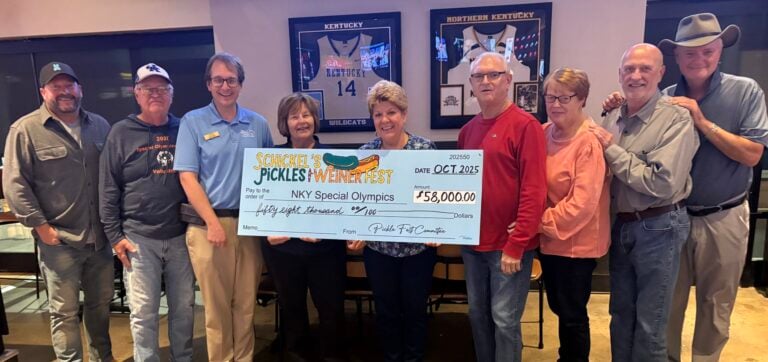The heroin and associated crime in Covington, Northern Kentucky, Greater Cincinnati, and indeed the whole Commonwealth has become completely intolerable. On the night Covington was celebrating its Bicentennial and building up its energy to build a brighter future in its Third Century, a female, presumed to be a heroin addict who earned her daily fix by turning tricks for a presumed common pimp, had her lifeless body dumped in a back alley way.
Heroin is not a Covington-only problem.
My first awareness that something was going wrong was about 7 years ago when a good friend of mine from growing up lost her 21-year-old son to an overdose. At the time it seemed strange that a child coming from a solid, middle class background who had every reasonable chance for a happy life would have had anything to do with needle drugs.
I’m a child of the 1970’s and perhaps no innocent. I can’t recall anyone in a very wide circle of people hanging in Devou Park, Covington, and the places to go in that era ever touching a needle. Something has changed. . .and changed for the far worse.

I became involved with Covington politics because of my background in finance. I hope and have reasonable expectations that my efforts in getting Covington back on its financial feet are succeeding and that, like my friend’s young son, have every reason to believe that we can have a chance for a happy, successful future; but not as long as this heroin epidemic continues to plague us.
Several quick stories and then to my point about what might be done.
The genius of our electoral system is that it forces candidates to go door to door throughout the city to earn votes, yes; but also in so doing you learn a lot of what is going on in a way no casual observer sees.
My mother’s family hails from John Street in West Covington. The family resided there for well over 90 years. During the campaign I knocked on a door of a lady who used to look after my Aunt as she aged. As glad as she was to see me and talk about family and local politics she rushed me inside to warn me of an impending disaster from a house several houses down where obvious drug dealing and bizarre behavior was evident. Police had been called and were placing the house under surveillance, and neighbors themselves put up cameras to capture what was going on. I did my part to call in what I learned about the sense that there was an eminent problem.
Unfortunately during the time that increased surveillance could yield a bust; a young mother zoned out on Xanax and rolled her baby up against the radiator, frying the child.
During three seasons of successive campaigns in almost every neighborhood in the city, conditions have worsened. It got to the point in a neighborhood I won’t mention where my campaign friend Robby Sweetser and I would compare notes not only as to how many voter contacts and yard signs we got but also as to how many times we were propositioned while going door to door by the end of the day. Yes, we phoned in what we saw.
The final heartbreak was in this last campaign when I worked on a sunny Saturday afternoon on a really nice street in Latonia. That day I knocked on 50 doors and reached 30 voters; three of whom were grandmothers raising their grandchildren because the children’s mothers were in jail for heroin. That’s 10%, one in ten houses on a good street where people take care of their properties and have aspirations for their children to participate in life, not to be alienated and self-destructive.
Early on this led me to work initially with Dr. Engels and his heroin task force. Dr. Engels is a force of nature and a man on a mission. I unfortunately only had so much time, but I did get his group in touch with our police and EMS services and other people in the City’s administration and wider health care community. I have voiced concerns as appropriate with state segislators that I work with who have access to tools to change policies that go far beyond what a city can do.
Unfortunately last year’s Heroin Bill known as SB 5 was held hostage in the House of Representatives in Frankfort. Games were played for political advantage and as a result no action was taken on meaningful funding for treatment or increased enforcement for serious dealers.
Yesterday, I was one of many citizens and local representatives who attended the Northern Kentucky State Legislator’s Caucus held in Florence. Three topics in particular came up, the Brent Spence Bridge, a proposed indoor smoking ban, and heroin.
President of the Kentucky Senate Robert Stivers has made it his business to see that a heroin bill was passed in the last three sessions only to watch them die in the House. Every local legislator promised to work on getting reform passed this year and one said that if they could not they all deserved to be booted in the next election. I am sure there is great willingness to produce something, anything in the form of a bill this year; but here are some of the obstacles.
There seems to be a consensus among Republicans who dominate the tate Senate that minimum sentencing should go up for dealers; some such as Senator Schickel believe that should be for any amount of dope sold. Personally I’d like to see that but for amounts over a small amount. I believe that there ought to be a distinction made between real dealers and addicts who might sell small amounts to support a personal habit. That said, if I had to err in a compromise I’d lean towards Senator Schickle’s position. An addict has at least a better chance of staying alive and perhaps getting treatment in jail than on the streets.
However jailing everyone in sight isn’t a great answer. Jail might be the best answer for some but clearly not all. Treatment and money for treatment has to be part of a one-two punch to truly knock this heroin epidemic out.
The medical treatment of addicts currently is almost impossible to obtain for lack of funding and some legal issues. I am very research driven and from my best efforts at self-education, I believe that Suboxone and Methadone treatment have greater chances of being successful in controlling addiction and returning our neighbors to a useful life than massive incarceration or 12 Step Programs alone. 12 Step Programs have their place and maybe in combination with Suboxone and Methadone may work better together.
Unfortunately there is a tension between the medical treatment of addiction and traditional 12 Step Programs which tend to see that using Suboxone and Methadone is simply substituting one addiction for another which is anathema to many 12 Step Purists.
Yes, that is true. Suboxone and Methadone are substituting one drug for another; but they allow the addict to function and return to society with a much better chance that they will stay off heroin.
In addition to this tension, there are other issues that have jammed up heroin bills. The most notable one has been the insistence in some quarters of having needle exchanges. Again I understand the animosity to this idea by those who do not want legal sanctions or to enable addicts to go on abusing drugs with more safety from contracting Hepatitis C and HIV AIDS.
I have my personal opinion. My academic credentials are in philosophy and ethics and I have spent a fair amount of time on business ethics where I am pretty much a T-totaler. However on the subject of heroin I am going to be a Pragmatist and a Utilitarian. For those who have not studied the thought of John Stuart Mill, Utilitarianism means trying to create the greatest amount of good for the greatest number of people knowing full well that you can’t make everybody happy.
I would advocate for yes, increasing sentencing; perhaps harshly for real dealers and maybe erring on the side of hitting some people who are not hardened criminals but who sell drugs simply to feed their habit; but allowing discretion by prosecutors and judges for giving people real access to medical treatment for their addictions. Both of those, incarcerating more people for longer and additional treatment whether in jail or in a closely supervised release will cost a lot more money. We will save some of that in restored productive lives and a reduction in property and nuisance crimes that reduce the quality of life for our citizens.
I am also probably going to cross party ranks by saying that we should seriously consider allowing needle exchanges, not so much to avoid encouraging illegal, bad, self-destructive behavior; but because in the long run it seems to me cheaper. It is inevitable that for those addicts who cannot make it to treatment, there is a six-month wait right now if an addict wants to try to get off junk. Given the mandate that our jails have to treat other medical conditions prisoners have.There are cures for Hepatitis C costing over $90,000. I have no idea the cost of treating prisoners with HIV AIDS but it has to enormous as well. Providing glass tubes with sharp points that are free from these diseases has to be a lot cheaper.
Feel free to agree or disagree with me. What I hope to do is spark debate and provoke you to contact your state Representatives. Some bill or another will emerge in Frankfort. Have your say and get some action. Call or email your state Representatives, state Senators and the Governor’s office.
Steve Frank is a Covington commissioner and vice mayor pro tem.























Here is a well written article on opioid and heroin addiction and why it needs to be treated as a medical condition in conjunction with either jail or counseling. Incarceration and / or counseling cannot by themselves undo the hardwired changes in the brain that these drugs do. This is from the National Institute of Health… not a hotbed of partisan politics: http://www.ncbi.nlm.nih.gov/pmc/articles/PMC2851054/